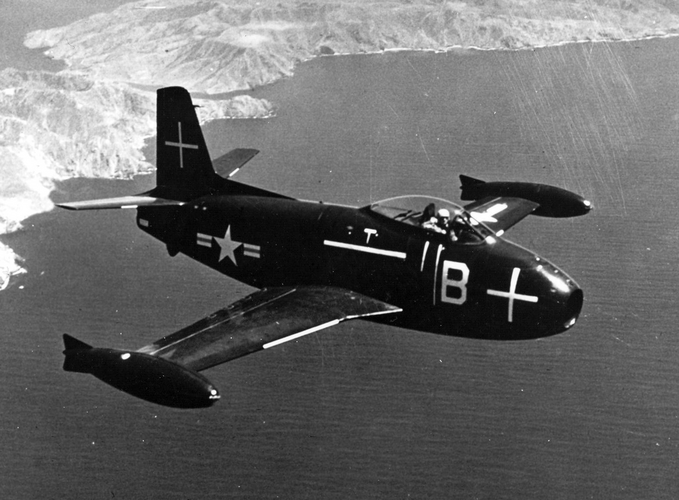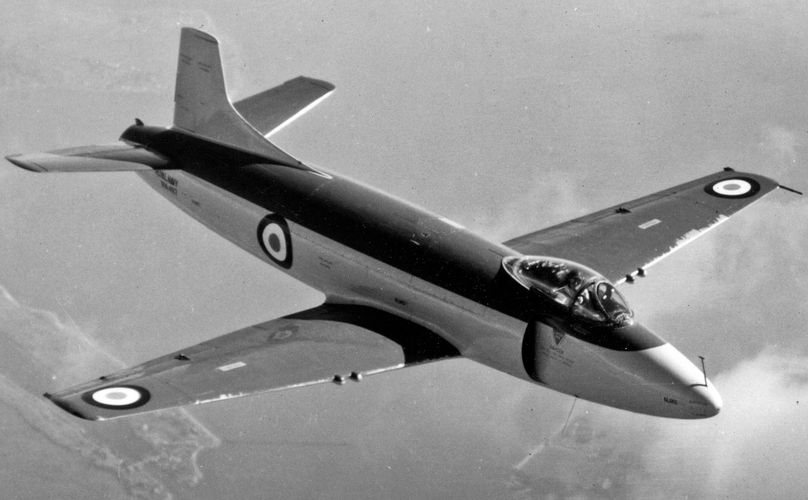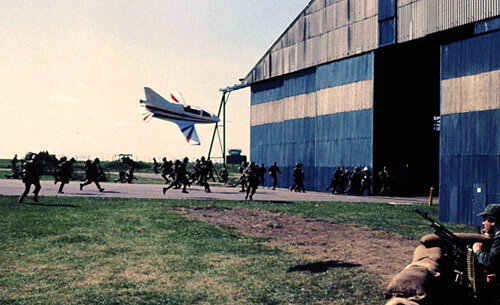You are using an out of date browser. It may not display this or other websites correctly.
You should upgrade or use an alternative browser.
You should upgrade or use an alternative browser.
Prop Aircraft conversions into Jets
- Joined
- 11 March 2012
- Messages
- 3,115
- Reaction score
- 2,942
We touched on this topic in another thread that was about piston to turbo-prop conversions.
The ultimate was the Chase/Fairchild C-123 which was originally built as an assault glider, then converted to a pair of piston engines, then booster jets added (the most widely used variant), Taiwan experimented with a turbo-prop conversion and finally the USAF test flew a pure jet version with a total of 4 jets in a pair of under-wing nacelles. C-123 was the only airplane to fly as a glider, piston, piston plus jets, pure jet and turboprop power.
Ted Smith built a single jet conversion to his mid-wing Aerostar light-twin (piston engines).
Beechcraft converted a King Air light-twin from turboprops to over-wing jets.
King Air was in turn a turboprop conversion of their piston-powered Queenaire. Queenaires may have only sold in small numbers, but more turbo-prop King Airs have sold than all other light twin turboprops combined.
The ultimate was the Chase/Fairchild C-123 which was originally built as an assault glider, then converted to a pair of piston engines, then booster jets added (the most widely used variant), Taiwan experimented with a turbo-prop conversion and finally the USAF test flew a pure jet version with a total of 4 jets in a pair of under-wing nacelles. C-123 was the only airplane to fly as a glider, piston, piston plus jets, pure jet and turboprop power.
Ted Smith built a single jet conversion to his mid-wing Aerostar light-twin (piston engines).
Beechcraft converted a King Air light-twin from turboprops to over-wing jets.
King Air was in turn a turboprop conversion of their piston-powered Queenaire. Queenaires may have only sold in small numbers, but more turbo-prop King Airs have sold than all other light twin turboprops combined.
Last edited:
- Joined
- 11 March 2012
- Messages
- 3,115
- Reaction score
- 2,942
Bell's nomenclature can be confusing because they used the P-59 designation for two totally different concepts. This was likely wartime maskirovka intended to confuse Nazis.
The first P-59 was a still-born, piston-powered fighter with a single propeller spinning between a pair of tail booms.
OTOH Bell only re-used the number when they started work on their first jet. Bell's P-59A Airacomet was a totally new fighter based upon a pair of early British jet engines. Maskirovka included installing a fake propeller during transit to Muroc Dry Lake Bed (now Edwards Air Force Base).
Tucker's XP-57 light fighter proposal never made it off the drawing board. While it shared a similar mid-engine configuration with Bell's P-39 Airacobra, they shared no common parts.
The first P-59 was a still-born, piston-powered fighter with a single propeller spinning between a pair of tail booms.
OTOH Bell only re-used the number when they started work on their first jet. Bell's P-59A Airacomet was a totally new fighter based upon a pair of early British jet engines. Maskirovka included installing a fake propeller during transit to Muroc Dry Lake Bed (now Edwards Air Force Base).
Tucker's XP-57 light fighter proposal never made it off the drawing board. While it shared a similar mid-engine configuration with Bell's P-39 Airacobra, they shared no common parts.
Last edited:
D
Deleted member 2278
Guest
You know that actually had me doubting myself for a moment.Bell's P-57A Airacomet
[Whisper] 9 [Whisper]
- Joined
- 13 June 2007
- Messages
- 2,099
- Reaction score
- 2,698
Paper dream only - no actual hardware.Apparently there was a XP-55 Ascender jet modification? I haven't seen any pictures of it though
Enjoy the Day! Mark
- Joined
- 13 June 2007
- Messages
- 2,099
- Reaction score
- 2,698
Dornier 328 to 328Jet is another one...
- Joined
- 13 June 2007
- Messages
- 2,099
- Reaction score
- 2,698
I have seen nothing in our Curtiss Wright-St. Louis folders, either on paper or in images. The reality was the XP-55 was a dead end approach to a fighter that the USAAF was not pursuing and a jet engine wasn't going to change that.Still, are there any drafts that have shown up?
We have wind tunnel model photos and a side profile drawing for the proposed cargo transport (P-274) using XP-55 design elements - I have seen artwork on the C-W St. Louis internal magazine for a jet powered version of that but other than the artwork, no drawings, documents or images.
Enjoy the Day! Mark
Attachments
BB1984
I really should change my personal text
- Joined
- 21 August 2011
- Messages
- 121
- Reaction score
- 198
. . . and I assume you mean from prop to "all jet", otherwise C-123 (as riggerrob has already mentioned) and B-36, and I think maybe a couple more that are slipping my mind right now. Edited to add more "prop to prop+jet" conversions:
- Lockheed P-2 Neptune
- Boeing KC-97
- Avro Shackleton
Last edited:
Nik
ACCESS: Top Secret
- Joined
- 15 July 2009
- Messages
- 1,241
- Reaction score
- 1,002
IIRC, the Bristol Brabazon Mk2 would replace #1's piston-engines with turbo-props, probably would have evolved to mix like the big US bomber with its combo of 'turning & burning'...
But, never got off the drawing board...
But, never got off the drawing board...
- Joined
- 27 May 2008
- Messages
- 1,116
- Reaction score
- 2,234
Sonex to Sub Sonex
Rutan Quickie to Twerp….. Oh, yeah ok that didn’t go well ….stay with the video, it’s final flight is in the latter part and everyone walked away unharmed;-
View: https://m.youtube.com/watch?v=YXm1nRpUPco
Rutan Quickie to Twerp….. Oh, yeah ok that didn’t go well ….stay with the video, it’s final flight is in the latter part and everyone walked away unharmed;-
Last edited:
T. A. Gardner
ACCESS: Top Secret
- Joined
- 18 February 2021
- Messages
- 1,031
- Reaction score
- 1,786
Fictional. Republic was designing the P-84 Thunderjet as their jet fighter entry.Was the P-47 jet conversion actually real or is it something fictional?
Another sort of conversion was North American's original XP-86 "jet Mustang" design. It used a new fuselage mated to P-51D wings and tail surfaces. The USN picked it up as the FJ Fury

- Joined
- 19 October 2012
- Messages
- 1,943
- Reaction score
- 1,828
To be clear, this is fake? https://www.militaryfactory.com/aircraft/detail.php?aircraft_id=1537
T. A. Gardner
ACCESS: Top Secret
- Joined
- 18 February 2021
- Messages
- 1,031
- Reaction score
- 1,786
Fake. There are clear engineering issues that would arrise with this design. First, the jet engine would be assumed to be ahead of the cockpit slightly aft of the original radial engine. This would require a very long tail pipe for the engine resulting in a loss of thrust. It would also require a redesign on the rear half of the fuselage to widen it to take this exhaust.To be clear, this is fake? https://www.militaryfactory.com/aircraft/detail.php?aircraft_id=1537
The cockpit would be another issue. Would there be room beneath it for the exhaust? How would it be kept insulated from the heat generated by that exhaust?
Then there are serious CG issues. You've removed the turbosupercharger and all associated ductwork, put a much lighter turbojet in the plane instead of a piston engine, and made other changes as well, such as--at least in the picture--added in a bunch of weight forward in armament and ammunition while removing this (I assume) from the wings.
Then there's the fuel issue. Turbojets consume far more fuel than piston engines do. Where do you cram all that fuel? That could lead to more serious CG issues as well...
Hence, why Republic chose to design the P-84 Thunderjet from scratch rather than do some lash up converting an existing design into a jet like the Russians chose to do early on.
If, as the narrative given, the J35 axial turbojet is used instead of a J31, then the whole exercise is a waste of time. The J35 wasn't available prior to WW 2 ending and post war there is no rush involved in getting a jet fighter into service. The USAF would have no reason to want to make some sort of lash up, half-solution out of an older piston engine fighter over designing a proper and clean design from scratch, especially when they already had these well advanced in 1945. Totally fake.
Actually, they are much closer to P-51H wings although they added the wing root extensions. The tailplane were also much bigger that the P-51D, even bigger than the P-51H. The fin/rudder is the same size as the F-82 fin/rudder. Another aircraft that used this wing was the T-2 Buckeye.Fictional. Republic was designing the P-84 Thunderjet as their jet fighter entry.Was the P-47 jet conversion actually real or is it something fictional?
Another sort of conversion was North American's original XP-86 "jet Mustang" design. It used a new fuselage mated to P-51D wings and tail surfaces. The USN picked it up as the FJ Fury
View attachment 676818
The image below was gleaned from this forum somewhere
Attachments
Last edited:
T. A. Gardner
ACCESS: Top Secret
- Joined
- 18 February 2021
- Messages
- 1,031
- Reaction score
- 1,786
Another plane where the designers mated a new fuselage to existing wings and tail surfaces is the Supermarine Attacker.

This time, Supermarine mated the wings and tail assemblies of the piston engine Spiteful to a new fuselage. They even left the jet a tail dragger... Early in it's development it was often referred to as the "Jet Spiteful."
Like the Jet Mustang, the Attacker had very pedestrian performance for a jet aircraft.

This time, Supermarine mated the wings and tail assemblies of the piston engine Spiteful to a new fuselage. They even left the jet a tail dragger... Early in it's development it was often referred to as the "Jet Spiteful."
Like the Jet Mustang, the Attacker had very pedestrian performance for a jet aircraft.
Similar threads
-
-
SAAB, Svenska Aeroplanaktiebolaget, Svenska Aeroplan AB, Saab AB aircraft list.
- Started by blockhaj
- Replies: 39
-
Soviet 57mm Aircraft cannons (N-57/OKB-16-57)
- Started by robotnikman
- Replies: 4
-
RR Griffon Griffon Mk 57/58, 88, or 130 with contra prop
- Started by negoshi8or
- Replies: 4
-
Early jet engine testing on the Czech He 219 (aka LB-79)
- Started by richdlc
- Replies: 3








